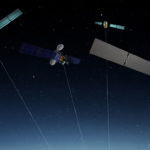
Researchers from the Department of Electrical Engineering at KU Leuven have designed authentication features that will make it even more difficult to send out false Galileo signals. Professor Vincent Rijmen and doctoral student Tomer Ashur from the Department of Electrical Engineering (ESAT) at KU Leuven have now advised the European Commission on ways to make Galileo signals more difficult to falsify. Their authentication method involves electronic signatures, similar to methods used for online banking.
To avoid delaying the launch of Galileo the researchers could only use the remaining ‘bits’ in the signals for authentication purposes. This is why researchers support the TESLA method for electronic signatures. TESLA signatures fit into 100 bits. The main disadvantage of TESLA is that the signatures in general are that they are only valid for a short period of time. However, for GNSS this does not matter as in the case of satellite navigation, the location is authenticated every 30 seconds or less.
The method still needs to be tested and validated before it can be made available to the general public. The authentication service is scheduled to become publicly available on a number of Galileo satellites in 2018. By 2020 the method will be fully operational. To use it, however, you will need a special receiver for Galileo signals that can also verify the electronic signatures. These receivers are currently in development.
